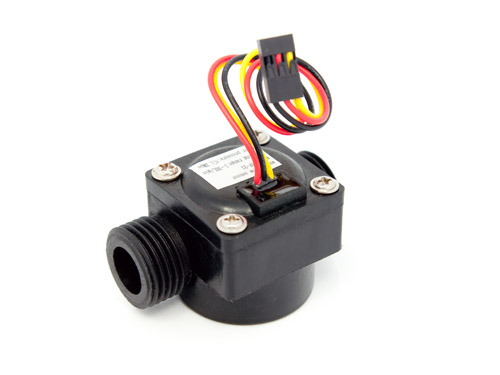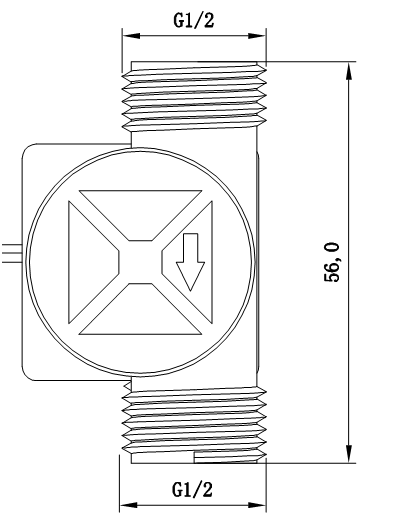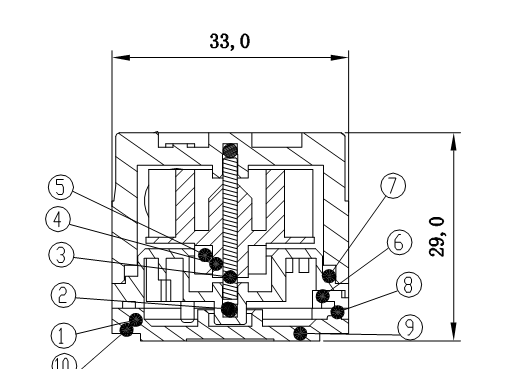Capteur de débit d'eau
De Wikidebrouillard.
Sommaire |
Introduction
Water flow sensor consists of a plastic valve body, a water rotor, and a hall-effect sensor. When water flows through the rotor, rotor rolls. Its speed changes with different rate of flow. The hall-effect sensor outputs the corresponding pulse Signal.
Model:POW110D3B
Specification
| Working voltage | 5V-24V |
| Maximum current | 15 mA(DC 5V) |
| Weight | 43 g |
| External diameters | 20mm |
| Flow rate range | 1~30 L/min |
| Operating temperature | 0℃~80℃ |
| Liquid temperature | <120℃ |
| Operating humidity | 35%~90%RH |
| Operating pressure | < 2.0MPa |
| Store temperature | -25℃~+80℃ |
Mechanic Dimensions
Sensor Components
| No. | Name | Quantity | Material | Note |
|---|---|---|---|---|
| 1 | Valve body | 1 | PA66+33%glass fiber | |
| 2 | Stainless steel bead | 1 | Stainless steel SUS304 | |
| 3 | Axis | 1 | Stainless steel SUS304 | |
| 4 | Impeller | 1 | POM | |
| 5 | Ring magnet | 1 | Ferrite | |
| 6 | Middle ring | 1 | PA66+33%glass fiber | |
| 7 | O-seal ring | 1 | Rubber | |
| 8 | Electronic seal ring | 1 | Rubber | |
| 9 | Cover | 1 | PA66+33%glass fiber | |
| 10 | Screw | 4 | Stainless steel SUS304 | 3.0*11 |
| 11 | Cable | 1 | 1007 24AWG |
Usage Example
Note: This example is abstracted from the forum, which was done by Charles Gantt. Thanks for his contribution.Let's see how it works.
Reading Water Flow rate with Water Flow Sensor
This is part of a project I have been working on and I thought I would share it here since there have been a few threads on how to read water flow rate in liters per hour using the Water Flow Sensor found in the Seeed Studio Depo. It uses a simple rotating wheel that pulses a hall effect sensor. By reading these pulses and implementing a little math, we can read the liquids flow rate accurate to within 3%. The threads are simple G1/2 so finding barbed ends will not be that hard.
Hardware Installation
You will need Seeeduino / Arduino ,Water Flow Sensor,10K resistor,a breadboard and some jumper wires.
Wiring up the Water Flow Sensor is pretty simple. There are 3 wires: Black, Red, and Yellow. Black to the Seeeduino's ground pin Red to Seeeduino's 5v pin The yellow wire will need to be connected to a 10k pull up resistor.and then to pin 2 on the Seeeduino.
Here is a fritzing diagram I made to show you how to wire it all up.

Once you have it wired up you will need to upload the following code to your Seeeduino. Once it is uploaded and you have some fluid flowing through the Water Flow Sensor, you can open the serial monitor and it will display the flow rate, refreshing every second.
Programming
// reading liquid flow rate using Seeeduino and Water Flow Sensor from Seeedstudio.com // Code adapted by Charles Gantt from PC Fan RPM code written by Crenn @thebestcasescenario.com // http:/themakersworkbench.com http://thebestcasescenario.com http://seeedstudio.com
volatile int NbTopsFan; //measuring the rising edges of the signal int Calc; int hallsensor = 2; //The pin location of the sensor
void rpm () //This is the function that the interupt calls
{
NbTopsFan++; //This function measures the rising and falling edge of the
hall effect sensors signal
}
// The setup() method runs once, when the sketch starts
void setup() //
{
pinMode(hallsensor, INPUT); //initializes digital pin 2 as an input
Serial.begin(9600); //This is the setup function where the serial port is
initialised,
attachInterrupt(0, rpm, RISING); //and the interrupt is attached
}
// the loop() method runs over and over again,
// as long as the Arduino has power
void loop ()
{
NbTopsFan = 0; //Set NbTops to 0 ready for calculations
sei(); //Enables interrupts
delay (1000); //Wait 1 second
cli(); //Disable interrupts
Calc = (NbTopsFan * 60 / 7.5); //(Pulse frequency x 60) / 7.5Q, = flow rate
in L/hour
Serial.print (Calc, DEC); //Prints the number calculated above
Serial.print (" L/hour\r\n"); //Prints "L/hour" and returns a new line
}
You can refer our forum for more details about Reading Water Flow rate with Water Flow Sensor.
Wiring Diagram
The external diameter of thread the connections use is 1.4mm.
Output Table
Pulse frequency (Hz) in Horizontal Test= 7.5Q, Q is flow rate in L/min. (Results in +/- 3% range)
| Output pulse high level | Signal voltage >4.5 V( input DC 5 V) |
| Output pulse low level | Signal voltage <0.5V( input DC 5V) |
| Precision | 3% (Flow rate from 1L/min to 10L/min) |
| Output signal duty cycle | 40%~60% |
FAQ
Here is the Sensors FAQ, people can go here to find questions and answers for this kind of products.
Question1: What type of materials the sensor is made out of that contact the water?
Answer: The water flow sensor is made of nylon with fiber. It should not be used with strong acid and strong base.
Question2: Is it safe to be used for drinking water?
Answer: Yes, it has been used on drinking machine.
Support
If you have questions or other better design ideas, you can go to our forum or wish to discuss.
Version Tracker
| Revision | Descriptions | Release |
|---|---|---|
| v1.0 | Initial public release | May 31, 2010 |
| v2.0 | Public release 2.0 | Jul 05, 2010 |
Resource
- Water flow sensor datasheet.pdf
- Reading Water Flow rate with Water Flow Sensor
- Water Flow rate display on LCD
- datasheet for the material
See Also
Other related products and resources.
Licensing
This documentation is licensed under the Creative Commons Attribution-ShareAlike License 3.0 Source code and libraries are licensed under GPL/LGPL, see source code files for details.
External Links
Links to external webpages which provide more application ideas, documents/datasheet or software libraries.
Crédits
Cette page est la traduction de celle-ci : http://www.seeedstudio.com/wiki/index.php?title=G1/2_Water_Flow_sensor
Traducteurs : machine et bidule - 2013 dans le cadre de Master 2 rédacteur traducteur 2013





